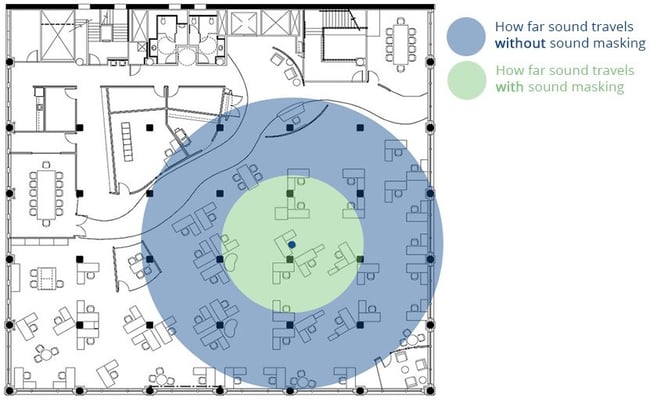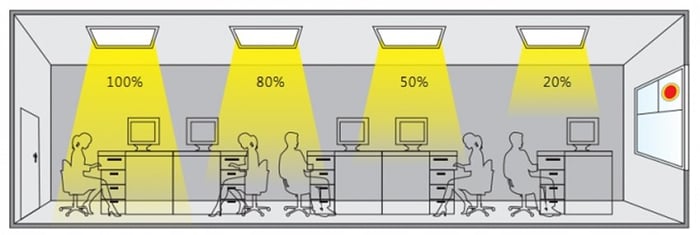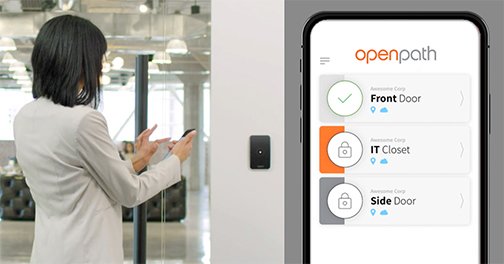Coworking spaces have become increasingly popular, and for a good reason. These stunning spaces are designed to encourage productivity, collaboration, and innovation at a reasonable price. Fear not though; you don’t need to relocate to experience the same benefits. There are several coworking concepts you can apply to your workplace to increase performance and satisfaction.
So, which concepts could make the biggest impact at your workplace?

1. Open Space Floor Plans
Coworking locations are known for their flexibility of non-assigned open workspaces. Often, there won’t be a cubicle in sight. These open floor plans are coupled with private offices, huddle rooms, conference rooms, phone booths, and comfortable common areas –to ensure people still have privacy when necessary.
This flexibility gives people the freedom to work where and how they want. A small, private room can help with deep-focus work. Other times a buzzing communal area might give you much-needed inspiration. Having the freedom to work in both environments is something that our workforce is coming to expect.

A study by Officevibe determined that 64% of people sharing an office with a coworker increased their tasks completed on time. Additionally, 68% of workers said they were better focused.
When you see people around you working hard, you’re more likely to do so yourself.
2. Next Generation Architectural Acoustics
Open environments invite more interactions and collaboration, but noise is noise. You want to be inspired and motivated by the people working around you, not distracted.
Enter: Sound Masking.

Many coworking spaces invest in sound masking systems, which add background noise to make speech less intelligible. This makes the background chatter feel more like coffee-shop noise than distracting watercooler banter.
(Related: What is Sound Masking?)
Additional elements must be taken into consideration to minimize noise. Flooring, furniture, wall panels, and layouts are all designed to dull loud distractions. A combination of these elements creates an environment that is energizing and conducive to work.
3. Smart Technology Enabled Environments
Technology allows us to work smarter, not harder, and coworking spaces have embraced smart building technology.
Conference and huddle rooms are fitted with the latest AV technology to ensure users can quickly and effortlessly connect from any device. Wireless presenting capabilities minimizes common touchpoints and eliminates the need for gadgets and dongles that clutter work surfaces. Smartboards, video conferencing, quality microphones and speakers, high-res displays, and room schedulers enhance the experience.
(Check out conference room solutions for the post-COVID office.)
Beacons and wayfinding can help visitors and employees locate elevators, open hot desks, access ramps, defibrillators, conference rooms, restrooms, and more. The beacons can trigger notifications when you arrive at your desk (“Reminder: Clock-in!”), send a cleaning alert to the janitorial staff when you leave the conference room, and collect location data to improve space utilization.

Quickly locate open hot desks, available conference rooms, access ramps, and more with wayfinding.
Perhaps the most important feature is a bandwidth capable of powering all of these devices. Optimal internet connectivity is a hallmark in coworking spaces and should be in your office too. It must be capable of supporting everyone’s needs wherever they are in the building.
4. Nontraditional Illumination, Access Control and Sustainable Design
With a “form follows function” design, coworking spaces make utility part of the aesthetic and contribute to coworking environments’ eco-friendly culture.
Intelligent lighting and IoT sensors work together to reduce energy consumption, cut costs, and improve user experience. This is accomplished through daylight harvesting, where overhead lights adjust according to the amount of natural light. Lights can also automatically turn on/off based on occupancy and schedules.

With daylight harvesting lights automatically adjust their brightness.
IoT sensors can also control room temperature based on occupancy, use UV light to sanitize a space, turn fans on/off, open/close blinds, and more.
Connecting all these electrical elements expands your building’s health, utility, and value while providing a more comfortable environment for the people inside.
5. A Feeling of Freedom Supported by a Sense of Security
The come-and-go nature of coworking spaces means physical security systems are imperative, and they’re equally important in your workplace.
Access control is an electronic system that regulates and restricts access to designated areas. You typically see this as key cards, key fobs, and now mobile apps used to open doors. Video surveillance adds a visual element to the security, recording people as they enter, exit, and move through the building.

Cloud-based access control solution by Openpath.
With a coworking space access control, if someone loses a key or gets fired, you don’t have to worry about security breaches or paying to replace the locks. This can be especially beneficial if you’re in a building where the people have a high turnover. When someone no longer needs access, you can easily revoke their access.
(See which systems coworking giant Industrious installed in their locations across the US.)
Monitoring and controlling the flow of people will help with loss prevention, occupancy management, tailgating, and gives you detailed records if you need to investigate a situation.
In addition to getting the right security systems in place, make sure you have clear policies and procedures. Everyone in your business should know how to keep themselves and the information they deal with secure. They should also know what to do in case of an emergency. Going over these critical protocols will help arm your employees with knowledge and protect your business.
The best coworking spaces are immersive and offer captivating design, delivering unexpected elements of fun and comfort. Coworking design benefits businesses by encouraging interactions. Companies both large and small are utilizing flexible space arrangements to better manage their liquid workforce.
While your business may not host multiple companies on-premise as coworking spaces do, you certainly have numerous employees, clients, departments, and teams working on-site and remotely.
Imagine how your people and your business could benefit from the concepts that make flexible coworking environments popular and productive. And envision the positive impact on your brand, company culture, employee morale, and your ability to attract and retain the best talent.

In fact, 60% of people who use coworking spaces claim they are more relaxed when they get home. And we all know happy employees are more engaged, have higher output, and have less turnover.
If you play a role in the workspace design, technology solutions, or are looking for ways to make your business more productive, enjoyable, and enticing, you need to consider these concepts.
Remember, coworking spaces provide more than just a chill vibe, chic interior, and cool member perks. They provide an environment that promotes creativity, encourages collaboration, and provides workers with more freedom and flexibility.
How much will implementing these coworking concepts cost? Use our workplace technology project calculator to get a free estimate.
Editor’s Note: This post was originally published in May, 2018 and has been updated for freshness, accuracy, and comprehensiveness.


Leave a Comment